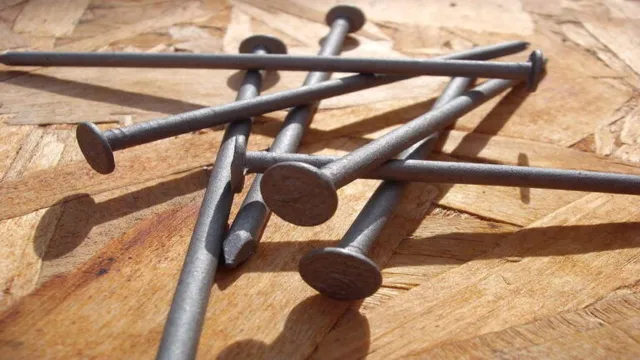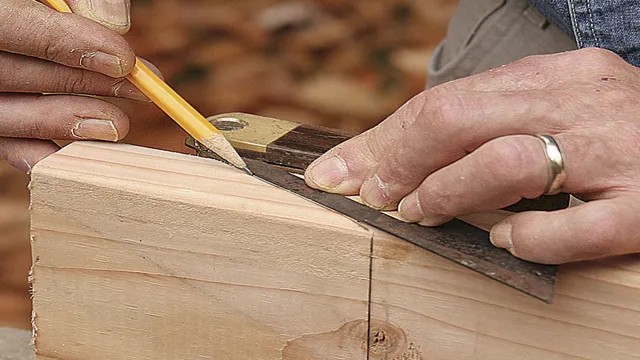What Size Brad Nails for Door Trim: A Comprehensive Guide

Adding door trim is a fantastic way to polish and enhance the look of your home. But, with countless nails to choose from, it can be challenging to determine which one is right for your project. One of the best options for door trim is brad nails, they come in varying lengths, making it easier to work with a broad range of wood densities.
By selecting the right size, your door frames will look sleek, and smooth, without any rough edges or protruding nails. In this blog, we’ll go over how to choose the perfect brad nail size to make your door trim installation a hassle-free experience. So, let’s get started!
Understanding Brad Nails
When it comes to door trim, one of the most commonly asked questions is “what size brad nails should I use?” The answer to this question depends on a few factors. First, you need to consider the thickness of your door trim. Thicker trim will require longer brad nails to ensure a secure fit.
Generally, 2-inch brad nails are a good option for thicker door trim, while 1-inch or 5-inch nails may suffice for thinner trim. Another factor to consider is the material of your door trim.
If you are working with hardwood trim, you may want to opt for slightly longer nails to ensure a strong hold. If your trim is made of a softer material, you can likely get away with shorter nails. It’s also important to use the correct gauge of brad nails.
For most door trim applications, 18-gauge nails are the best choice. However, if you are working with particularly thick or hard material, you may want to consider using a 16-gauge brad nail for added strength. Overall, choosing the right size and gauge of brad nails for your door trim comes down to considering the thickness and material of your trim.
By taking these factors into account, you can ensure a clean and secure installation that will stand the test of time.
What are Brad Nails?
Brad nails are small, thin nails that are commonly used in woodworking projects. They are very similar to finishing nails, but they are smaller in diameter and have a thinner gauge. Brad nails are typically between 18 and 23 gauge, with lengths ranging from 5/8 to 2 inches.
They are often used for attaching delicate trim pieces, as they are less likely to split the wood. Also, they don’t require as much force as other nails, making them perfect for such tasks. Brad nails are commonly used in finish work, such as baseboards, crown molding, door and window casings, and other similar applications.
They are also used for upholstery work, as well as in the construction of small wooden boxes and cabinets. With their precision and versatility, brad nails are an essential tool in any woodworker’s toolkit.

Why Use Brad Nails for Door Trim?
When it comes to trim work on doors, using brad nails can be an excellent choice. Brad nails are small, thin-gauge nails that are perfect for attaching trim pieces to delicate surfaces such as doors. They are less noticeable than larger nails, and can easily be concealed under a coat of paint or stain.
They also cause less damage to the wood than screws or larger nails. The burstiness of brad nails means they don’t split the wood, and they are also less likely to leave a noticeable hole, making them ideal for finishing work. In addition to their practicality, they are also easy to use, especially when you have a brad nailer.
Simply load up the nail and start nailing away. Overall, brad nails are an excellent choice when doing trim work on doors, offering durability, discreetness, and ease of use.
Factors to Consider
Choosing the right size of brad nails for door trim can seem like a daunting task, but it’s essential to ensure the durability and structural integrity of your project. The size of the nail you choose will depend on the thickness and density of the wood you’re working with. The most commonly used brad nail sizes for door trim are 15-gauge and 18-gauge.
The 15-gauge nails are thicker and more substantial and are best suited for thicker and denser wood. The 18-gauge nails are thinner but still provide a sufficient hold for lighter and thinner wood materials. It’s essential to consider the length of the nail as well.
The longer the nail, the deeper it will go into the wood, providing a stronger hold. However, be sure not to use nails that are too long, as they could split the wood. Ultimately, it’s crucial to take time to consider all the factors and choose the right size brad nail for your door trim project to ensure optimal results.
Type of Door Trim
When it comes to choosing the type of door trim for your home, there are a few important factors to consider. Firstly, you’ll need to take into account the style of your home and the existing decor. For example, if your home has a more traditional feel, you may want to opt for wooden trimming, while those with a more modern aesthetic may prefer sleek metal or glass accents.
Another important factor to consider is the durability and maintenance required. Certain materials like wood may require more upkeep than others, which is something to keep in mind if you’re looking for a low-maintenance option. Kudos to those who have extra time and want to further enhance their home’s style and look, as different types of door trims can improve the overall character and vibe of your home.
Therefore, it’s important to carefully weigh your options and choose a door trim that not only meets your functional needs but also complements your home’s unique style and decor.
Material of Door Trim
When it comes to door trims, the material chosen plays a significant role in the overall look and feel of your interior. There are several factors to consider when selecting the material for your door trim. Firstly, consider the style of your home.
Is it modern or traditional? This will help determine the type of material that will best suit your door trim. For a modern look, a sleek and glossy material like glass or metal can be used, while for a more traditional feel, a classic wood trim may be a better choice. Secondly, consider the durability of the material.
If the door trim will be subjected to heavy use, a sturdy and durable material like PVC or aluminum may be the best option. Lastly, consider the cost of the material. While there are many options available, some may not fit within your budget.
Taking these factors into account will ensure that you select a door trim material that meets your specifications and gives your interior the desired look.
Thickness of Door Trim
When it comes to door trim, the thickness is an important factor to consider. There are a few key things to keep in mind when deciding on the right thickness for your door trim. Firstly, the overall look and style of your home should be taken into account.
If your home has a more traditional vibe, thicker door trim may be more appropriate. On the other hand, if you prefer a more modern look, thinner door trim may be a better fit. Another factor to consider is cost – thicker door trim can be pricier than thinner options.
Additionally, thicker door trim can be more difficult to install, so it’s important to factor in installation time and skill when making your decision. Ultimately, the thickness of your door trim should be determined based on your personal preference, budget, and home style.
Recommended Brad Nail Sizes
When it comes to door trim, the size of brad nails you use can make all the difference. The two most common sizes for brad nails when installing door trim are 18-gauge and 16-gauge nails. Both sizes are small and thin, which makes them perfect for delicate trim work.
The 18-gauge brad nails are the smallest and are great for finishing work or for holding thin pieces of trim in place. They are typically 25 inches in length and can be used for almost any project that requires a small nail.
On the other hand, the 16-gauge brad nails are slightly larger and are perfect for use with thicker trim or more substantial molding. These nails are typically around 2 inches long, and they are strong enough to hold trim in place without leaving visible holes or causing damage. Whatever size you choose, it’s important to ensure that the nail heads are small enough to be concealed by the trim.
Too large of a brad nail can leave unsightly holes or damage the look of the trim. So, be sure to pay attention to the size of the nail you use to get the best results when installing door trim.
1 ¼ inch Brad Nails for Thin Trim
When it comes to choosing the right brad nail size for your thin trim, 1 ¼ inch nails are a great option to consider. These nails are long enough to securely hold your trim in place without being too thick and bulky. Plus, they are compatible with most brad nailers on the market.
It’s important to choose a brad nail size that is appropriate for the thickness of your trim, as using nails that are too small or too large can compromise the structural integrity of your project. Luckily, 1 ¼ inch nails are a versatile size that can be used for a variety of thin trim applications. So next time you’re working on a woodworking project, be sure to consider using 1 ¼ inch brad nails for your thin trim.
1 ½ inch Brad Nails for Medium Trim
When it comes to choosing the right nail size for your medium trim projects, 1 ½ inch brad nails come highly recommended. These versatile nails are ideal for attaching medium-sized trim pieces, such as door casings and baseboards, to walls and other surfaces. Whether you’re a professional contractor or a DIY enthusiast, choosing the right nail size is crucial to achieving a flawless finish.
Using brad nails that are too long or too short can lead to splitting or cracking of the trim, which can be time-consuming and frustrating to fix. That’s why opting for 1 ½ inch brad nails is a safe bet for most medium trim applications. With their thin profile and minimal head size, these nails are easy to conceal and provide a secure hold without damaging the wood.
So, if you’re planning your next trim project, remember to stock up on 1 ½ inch brad nails for a professional-grade finish that will stand the test of time.
2 inch Brad Nails for Thick Trim
Are you wondering what size of brad nails to use for thick trim? If so, you’ll want to consider the 2 inch size for optimal results. Using the right size brad nail is crucial for ensuring your trim stays securely in place. Thick trim requires a stronger hold, which is where the 2 inch brad nails come in handy.
These nails are long enough to penetrate through the thick trim and into the wall, creating a durable hold that will last. Using a smaller size nail may result in the trim coming loose over time, which can be frustrating and time-consuming. To prevent this from happening, make sure to use 2 inch brad nails for your thick trim projects.
Trust us, your trim will thank you for it!
Conclusion
In conclusion, the size of brad nails for door trim ultimately comes down to personal preference and the specific project at hand. Whether you opt for a tiny 18-gauge or a sturdy 15-gauge, the key is to ensure that your nails are strong enough to securely fasten the trim without causing any splits or damage. So go ahead and nail it like a pro, with the perfect size to bring your door trim to life!”
FAQs
What is the door trim made of?
The size of brad nails for door trim can vary based on the material of the trim. If the trim is made of softwood, 18-gauge nails with a length of 1 1/4 inches can be used. If the trim is made of hardwood, 16-gauge nails with a length of 2 inches should be used.
Can I use a different type of nail for door trim?
Brad nails are the best type of nail to use for door trim as they are thin and leave a small hole that can easily be filled with putty. However, if you don’t have brad nails, finish nails can also be used as long as they are small enough and won’t split the wood.
Can I use a nail gun for door trim?
Yes, a nail gun can be used for door trim as long as it is adjusted to accommodate the size and type of nail being used. It’s important to test the gun on scrap pieces of trim before using it on the actual project to ensure it’s set up correctly.
What length of brad nails should I use for thin door trim?
For thin door trim, 18-gauge brad nails with a length of 5/8 inch can be used. These nails are small and won’t split the thin trim.
How many nails should I use for door trim?
It depends on the length of the trim and the spacing you prefer, but a general rule is to use one nail every 10-12 inches. For crown molding, it’s recommended to use two nails per stud to ensure stability.
Can I use glue instead of nails for door trim?
Yes, adhesive can be used along with nails for door trim to provide extra support. However, nails should still be used as the primary fastener.
What type of brad nailer should I use for door trim?
A pneumatic brad nailer is the best type of nailer to use for door trim as it provides consistent and efficient nailing. However, a cordless brad nailer can also be used as long as it’s powerful enough for the material being used.







